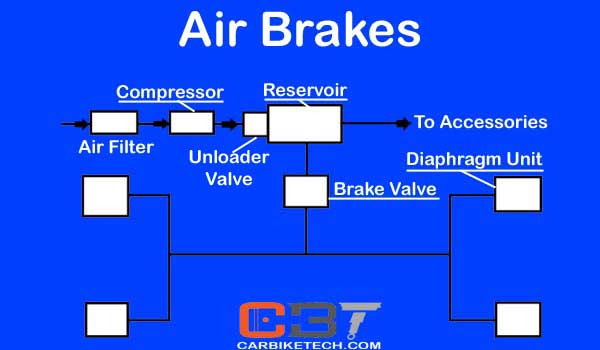What is Air Brakes System?
Air brakes systems are generally used in heavy commercial vehicles and trucks. They need a heavier braking effort than that can be applied by the driver’s foot alone. You apply the pressure of compressed air to operate Air brakes instead of just foot pressure that acts against flexible diaphragms in the brake chamber. These diaphragms connect to the brake rods that connect to brake-operating cams or “S” cams on the wheels. Manufacturers sometimes also refer to this brake system as Power Brakes.

Air Brakes vs ABS system:
Air brakes systems used in heavy vehicles and trucks are far different in design and operation than the “Antilock braking system” used in cars. Air operated brakes are NOT the same as ABS while ABS DOES NOT stand for Air brakes either. Many people get confused about this because of the similarity in their pronunciation. However, both systems are quite different from each other in design and operation. Manufacturers use Air operated brakes mainly for heavy applications such as trucks and buses while lighter applications such as cars mainly use the Antilock braking system.
Components:
Typical Air brakes systems consist of a compressor, a reservoir, a brake valve, and diaphragm units. The function of the air compressor is to compress the air and send it to the air reservoir for storage. The air reservoir stores the compressed air in it for later usage. The function of the unloader valve is to release the excessive air pressure to the atmosphere. The brake valve functions as a control valve and directs the pressurized air to the respective diaphragm to expand it. The function of the diaphragm is to expand due to the compressed air pressure and operate the “S” cam shoes and thereby the brakes.

The functioning of Air Brakes System:
A hand or foot-operated valve controls these diaphragms. When the driver applies brakes, the brake-valve controls the braking operation, directing the flow of air from a reservoir against diaphragms in the brake chambers. It directs the air form brake chambers to the atmosphere when the driver releases the brakes. The engine drives the air compressor that furnishes compressed air to the reservoir when it falls below the set value.
Application:
Air brakes systems are very powerful as compared to the ordinary mechanical or hydraulic brakes. Hence, manufacturers widely use them in heavy vehicles. The brake linkage mainly consists of a pipeline. Besides braking, you can use compressed air from the reservoir for inflating tires, operating windscreen wipers, horns, and many other accessories. Bendix, Girling, and TVS are some of the leading manufacturers of air-operated brakes in the world.
Watch Air brakes system in action here:
Read More: How Diesel Engine works?>>
